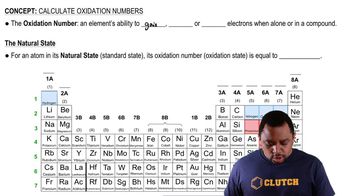Indicate whether each of the following statements is true or false: (c) If there are no changes in the oxidation state of the reactants or products of a particular reaction, that reaction is not a redox reaction.
For each of the following balanced oxidation–reduction reactions, (i) identify the oxidation numbers for all the elements in the reactants and products and (ii) state the total number of electrons transferred in each reaction. (a) 2 MnO4-(aq) + 3 S2-(aq + 4 H2O(l) → 3 S(s) + 2 MnO2(s) + 8 OH-(aq)
 Verified step by step guidance
Verified step by step guidance
Verified Solution
Key Concepts
Oxidation Numbers

Redox Reactions

Balancing Redox Reactions

Indicate whether each of the following statements is true or false: (c) An oxidizing agent is needed to convert CO into CO2.
For each of the following balanced oxidation–reduction reactions, (i) identify the oxidation numbers for all the elements in the reactants and products and (ii) state the total number of electrons transferred in each reaction. (b) 2 Hg2+(aq) + N2H4(aq) → 2 Hg(l) + N2(g) + 4 H+(aq)
Indicate whether the following balanced equations involve oxidation–reduction. If they do, identify the elements that undergo changes in oxidation number. (a) PBr3(l) + 3 H2O(l) → H3PO3(aq) + 3 HBr(aq)
Indicate whether the following balanced equations involve oxidation–reduction. If they do, identify the elements that undergo changes in oxidation number. (b) NaI(aq) + 3 HOCl(aq) → NaIO3(aq) + 3 HCl(aq)
Indicate whether the following balanced equations involve oxidation–reduction. If they do, identify the elements that undergo changes in oxidation number. (a) 2 AgNO3(aq) + CoCl2(aq) → 2 AgCl(s) + Co(NO3)2(aq)
